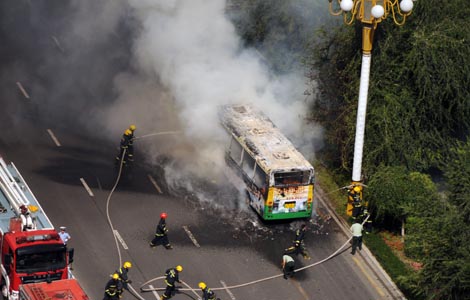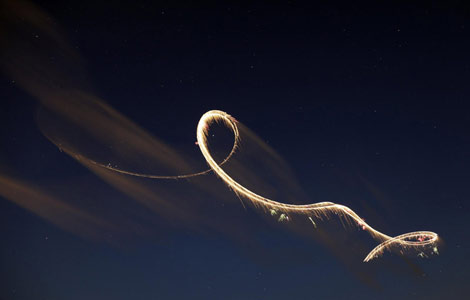TEPCO leak worse than first reported
Updated: 2013-08-06 09:31
(Agencies/China Daily)
|
||||||||
TEPCO admits size of tritium spill after Japanese government probes
Tokyo Electric Power Co has announced to the public the amount of radioactive tritium that has leaked into the Pacific Ocean since its Fukushima nuclear power plant was crippled by a tsunami more than two years ago.
Local media reported on Monday that TEPCO admitted that 20 trillion to 40 trillion becquerels of the highly radioactive material likely leaked into the sea following the crisis in March 2011, at the nuclear facility in Japan's northeast.
The reports contradict TEPCO's original claims that they had managed to contain the toxic water within the confines of the crippled plant.
Following probes from Japan's nuclear watchdog and claims by overseas regulatory bodies about TEPCO's ineptitude and lack of transparency regarding the severity of the nuclear leakage, the embattled utility finally conceded the scale of the radioactive tritium leak.
Media reports on Monday quoted a TEPCO spokesperson as saying that between May 2011 and July 2013, around 22 trillion becquerels of toxic water had been released into the Pacific Ocean annually from the stricken six-reactor plant.
The spokesperson said the company would also conduct tests to estimate the amount of cancer-causing strontium that may also have leaked into the Pacific Ocean during the same period.
TEPCO's ambiguity and lack of transparency has consistently drawn the ire of foreign nuclear experts and regulatory bodies.
"These actions indicate that you (TEPCO) don't know what you are doing ... You do not have a plan, and that you are not doing all you can to protect the environment and the people," Dale Klein, former head of the US Nuclear Regulatory Commission, told a panel in Tokyo last month.
The utility has been plagued with a series of problems of late as it struggles to deal with huge amounts of radioactive water that has to be constantly kept cool by injecting water into the reactors.
Reports on Monday also confirmed that radioactive groundwater at the plant is rising above a protective barrier built specifically to contain it.
This contaminated groundwater is likely seeping into the sea, exceeding legal limits of radioactive discharge, and a workaround planned by TEPCO will only forestall the growing problem temporarily, Shinji Kinjo, head of a Nuclear Regulatory Authority task force, told Reuters.
"Right now we have a state of emergency," Kinjo said, saying there is a "rather high possibility" that the radioactive wastewater has breached the barrier and is rising toward the ground's surface, Kinjo said.
A TEPCO official said the utility was taking various measures to prevent contaminated water from leaking into the bay near the plant.
It was not immediately clear how much of a threat the possible increase in contaminated groundwater could cause. In the weeks following the 2011 disaster that destroyed the plant, the Japanese government allowed TEPCO to dump tens of thousands of tons of contaminated water into the Pacific Ocean in an emergency move.
Experts say that this is adding to the risk that yet more contaminated material will leak into the Pacific Ocean, as 400 tons of fresh groundwater is poured into the plant daily.
Along with its ongoing battle to limit radioactive leaks into the ground and ocean, TEPCO is also facing a massive, costly cleanup operation and compensation costs that will likely force the company into permanent receivership.
Xinhua-Reuters
Most Viewed
Editor's Picks

|

|

|

|

|

|
Today's Top News
Drifting left, Asian American voters still back John Liu
Beijing sincere on S China Sea Code of Conduct
Washington Post sold to Amazon's founder
Fonterra says sorry for 'anxiety'
Obesity rate on the increase
Detroit Symphony brings China to NYC
Service sector drives up growth
Globalization of Chinese culture becomes hot topic
US Weekly

|

|













